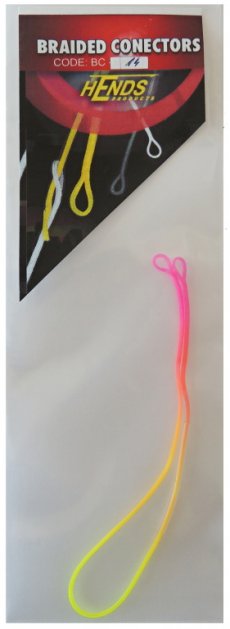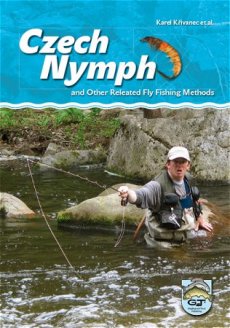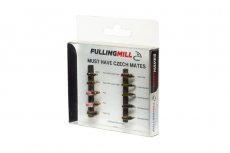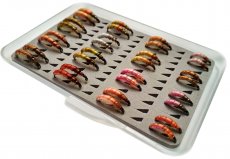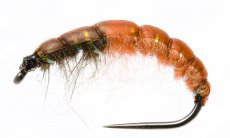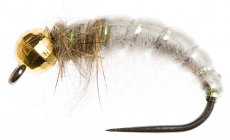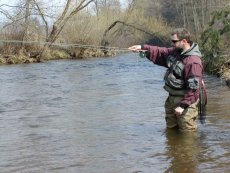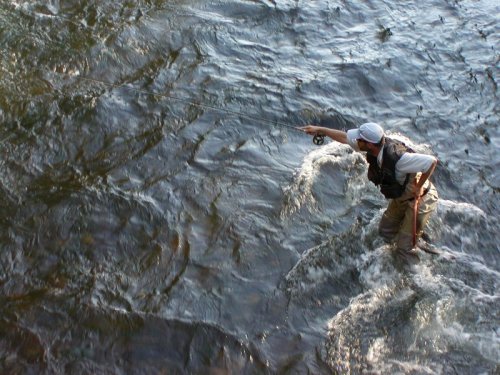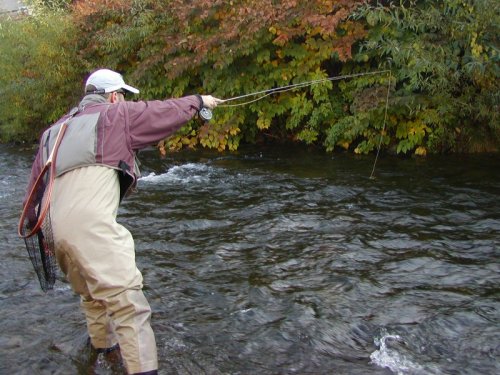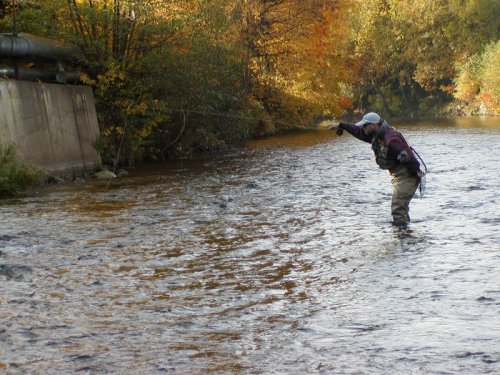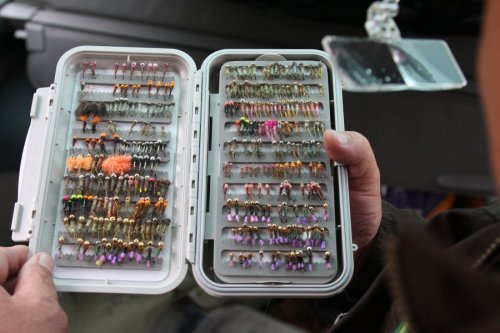The article that summarizes all about the Czech nymphing technique.
The development of mayflies, stoneflies, sedges, midges and other insects takes place on the bottom, under stones, among underwater plants and in sediments. Have a good look at the river bottom in some shallows. Turn over a few stones, take out a sunken branch or wash a bit of pool mud through a sieve. You will see a real abundance of life. Among other things you will discover various nymphs and larvae, as well as an animal of approximately 1 cm length - the scud - freshwater shrimp. Most animals you find under the water surface are an indispensable part of the menu of that which is our primary focus and passion - the fish we try to catch with our flies. Already after a short look at life under the water mirror it is not difficult to understand why nymph-fishing is successful. When nymph-fishing on flowing waters we fish with flies in the water column, often near or along the bottom, meaning exactly in those places where most of the fish food is and where fish are readily feeding. When nymph-fishing, we most often imitate scuds - fresh water shrimps - as well as nymphs of mayflies, caddis flies and midges. For many fishermen, nymph-fishing will never equal the classic dry fly fishing and its beauty. But thanks to its effectivity this method is indispensable for the modern flyfisher, and will bring a lot of unforgettable experiences to those who master nymph-fishing.
What's Czech nymphing?
The Czech nymph and Czech nymphing are a special fly and method of nymph fishing that developed in the regions of middle and eastern Europe. The original Polish nymph was adopted by Czech fishermen during the 1980s. In particular, top Czech competitors have experimented with this new method, developed it, and brought it nearly to perfection. The principle of nymph-fishing with the Czech nymph is short-distance fishing, practically under the tip of the rod, that is held with an outstretched arm. The flyline hangs under the tip of the rod, and its end often does not even touch the water surface. Two or three nymph flies of various weights are used. Some of the classic Czech nymphs are the so called Bobeshs - the original Czech name which needs no translation since the technique has quickly spread and is now widely used. But other types of flies are used also (jig flies, flies with beads etc.). Czech nymphs are weigthed flies tied on gammarus hooks, imitating fresh water shrimps or the caseless larvae of sedge flies. Imitative as well as colorful patterns are used, mostly in sizes 8 - 16. The Czech nymph is quite a simple fly to tie. It is characterised by a rounded (bent) gammarus hook, that is weighted with a lead wire. The body is created from natural or synthetic dubbing. Another typical feature of a Czech nymph is the back, made from latex foil or a material with similar characteristics. For the ribbing of the fly monofil or coloured wire is used. A real Czech nymph is always tied very thin, so that it sinks very quickly towards the bottom.
History of Czech Nymphing
Paradoxically, the history of the Czech nymph has its beginning in Poland. During the international fly fishing competition there in 1984, the Czech competitors got acquainted with the method of fishing at short distance used by local competitors. Most of the Polish competitors were forced to fish short, because they had no fishing lines at their disposal and had to substitute them with thick nylon monofilament. Flies used by the Poles were imitations of Hydropsyche and Rhyacophila sedges. The Czech competitors picked up the short nymph method very quickly, and by the next year they were using it during the World Championship, which took place on the Polish river San and where Czech team won second place - just behind the Poles! In 1986, this short nymph method brought the first gold medal for the Czech team, when the Czech Slavoj Svoboda won the title of world champion in Belgium. The first Czech nymphs were tied from materials that would bring smiles to the faces of today´s fly tiers. Imagine a plastic foam body from a washing sponge, ribbing from horse hair and a back from a mackintosh or bast. The use of gammarus hooks gave the Czech nymph its characteristic shape, and the initial thick patterns evolved into thinner ones with the appearance of new higher quality tying materials. At the beginning of this history, imitative patterns like scuds and caddis larvae were preferred. The originally monotone bodies of these flies were later enriched by various colour spots, and this trend has gone so far that in today's fly boxes we can find nymphs of various colour combinations not having anything in common with natural patterns.
Technique
The basic method of fishing with Czech nymph is the so called short nymph (or rolled nymph). When using this method we are fishing practically under the tip of the fly rod, often without even using the fly line which doesn't touch the water surface in most situations. After casting upstream, we let the flies gradually sink to the bottom and follow their movement downstream with the tip of the rod. Our arm with the rod is stretched out in front of us the whole time. When the flies have floated down to where we stand, they are lifted from the bottom with an upwards movement of the rod and cast again. In order to be successful with the short nymph method, we need to keep in permanent contact with the flies. A fish take is indicated by any inconspicuous movement of the leader or flyline upstream or to the sides, or even just a short hesitation by the flies as they move through the water. When we don't keep our contact with the flies, the chance of feeling a take is markedly reduced. There are several things to do to help keep contact with the flies. First the flies must be properly "led" through the water and the rod and line must follow their movement, while all the time trying to keep the leader taut. Another important factor is the length of the leader. When short, it's easier to keep contact with the flies. Last but not least, it is very important to have a flies properly weighted. Keeping contact with heavier flies is much easier than with lighter ones (lighter flies, however, behave more naturally in the water). Czech nymphs don't have to be used just "short", and similar success can be had using the "long" method, when the flies are cast farther upstream and we let the fly line float on the surface. Takes are then identified by movements or hesitations in the line tip. Depending on conditions, we can combine both these short and long methods, and fish up, down and across the stream.
Equipment
A universal and generally recommended set-up for fishing with Czech nymphs is an AFTMA 5 rod of length 275 cm (9 feet). We use a normal double tapered line of the same class as the rod. Recently, there has been a trend towards using lighter rods (AFTMA 4, 3 or even 2). It is important to use a rod as light as possible, because when using the Czech nymph technique (fishing with the arm stretched forward, frequent casting) we feel every superfluous gram. The leader is made of three sections of monofilament (there is no need for tapered) of 0,12 - 0.18 diameter. The length of the leader shouldn't exceed the length of the rod. A useful part of the system for Czech nymphing is a strike indicator. Since many takes are identified by the movements of the line, it is always helpful to have the line end be well visible. For this, the so-called speed connectors in different colours are very popular, and are also a good device for connecting the flyline and the leader. The last important equipment of the Czech nymph fisherman are wading trousers. As we are looking for fish at a short distance, it is often necessary to wade to places, where we would just cast to with other methods. Other parts of the gear do not differ from that used with other techniques.
Tactic
Tactics of fishing with the Czech nymph will always differ according to current conditions and universal directions for right tactics do not exist. In any case it is important to take several checked up facts into account: Where to fish: With a Czech nymph we usually fish in shallow as well as in deep currents and in the boundary lines between them and eddies and calm pools. We look for places, where there are deep places (pits), in these there are often fish. We will be successful also in deep pits between two currents and near bunches of water plants like water buttercups. When to fish: When reading some foreign journals we can get an impression, that the Czech nymph method can be effective only when it is used for catching grayling in winter. On the contrary, Czech nymph is successful all the year round. Especially effective it is (when compared with other methods) during times of high water, as after a rain, when other methods are failing, because with them it is difficult to get a fly to places, where fish are feeding. Practically in most cases, when we cannot see any fish activity on the water surface, it pays to use the Czech nymph method.
How to fish
We fish at a short distance, often only so far, that the distance ist just a bit larger than the length of our rod. We leave the flies drift freely, only during the end phase we often meet with success, when we let the flies rise from the bottom to the surface. Proper weighting of flies is important. The flies must be heavy enough to sink to the required depth, but on the other hand they must not be weighted too much, so as they do not often get snagged on the bottom and also when overweight, they can not be led through the water as naturally as possible. Weighting of the flies we must flexibly adjust to depth and speed of the current. During the actual fishing the flies must be as near to the bottom as possible in places, where we expect a bite. Regarding the short distance we are fishing at, we must be careful not to spook the fish. While fishing in clear or shallow water, the effectivity of our fishing can be remarkably increased, when we lower our silhoutte. What fish: Grayling is the fish, that responds to the Czech nymph best. But we can successfully fish for brown and rainbow trout, chub, dace, roach or barbel. What flies: There is no general rule determining the most effective pattern of Czech nymph. When we do not know, to what flies the fish will positively respond, we put three fly patterns on the leader, in distinctly various colour combinations and test the effectivity of individual patterns. Usually a natural pattern is tied as the tip fly or first dropper and a "wilder" pattern as the second dropper. The deeper the water and the larger the fish we are expecting, the larger fly patterns we can use. For fishing for brown trout imitative patterns are more suitable, for rainbow trout and grayling beside natural patterns we use various colour combinations, having nothing in common with imitations of natural food. For catching non-salmonids flies of "sober" colours are best.
Flies
The basic pattern for fishing with Czech nymph is a fly, in Czech called Bobeš (read bobesh = Czech nymph). It is a weighted fly tied on a Gammarus hook. The Czech nymph imitates freshwater scuds, caseless caddis larvae, or is tied in absolutely fantastic colour combinations. A true Czech nymph must be thin, to sink as near to the bottom as possible during its short trip through the water. Sizes of the flies differ according to fishing conditions (water depth, clarity, current speed, size of fish etc.). The most used sizes for European waters are #10 and #12. When nymph fishing on large rivers or expecting a strike of a large fish we often use flies up to the size #6. On small streams we can get down to nymph size #16. Czech nymph is not the only type of a fly, we can successfully use for Czech nymphing. Also other types of artificial flies are effective, like jigs, nymphs with beads (gold, silver, brass), classical nymph types (pheasant tail, hare´s ear etc.) or nymph tied on special hooks (e.g. nymphs tied on hooks with a drop). We can combine types, patterns, sizes and colours of the flies to our heart´s content and there is no guaranteed or best combination. When we know, what flies the fish are taking, we can fish with three identical patterns. In a situation, when we are not acquainted with the river or do not know the fish appetite, there is nothing left but to make some experiments and in such a case it gives us an advantage, when we tie on three different flies in different colours and sizes.








